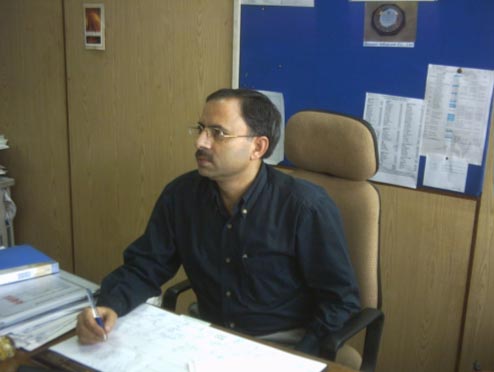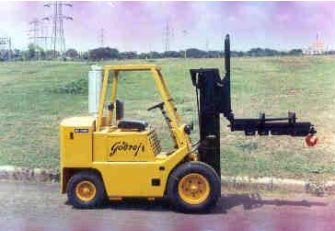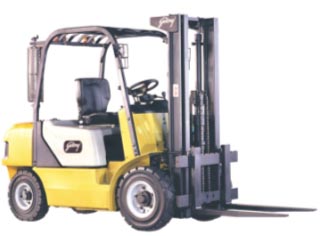The populous Asian nation has traditionally used manpower to lift heavy loads and logistics is still a new concept. But things are changing. The country has opened its market to multinationals and international forklift brands. There is a move towards mechanisation and Indian forklift businesses are excited about what that means for the industry. Christine Liew reports.Manpower vs machine powerIn 1963, India's first forklift manufacturer,
Godrej & Boyce Manufacturing Co Ltd, based in Mumbai, collaborated with Clark Material Handling, USA, to pioneer materials handling in the country. The first machines produced had automatic torque converter transmission. Today, Godrej's Mumbai plant produces 125 forklifts each month.
Godrej is a household name because it also manufactures diverse products ranging from consumer products and home appliances to furniture and security equipment. In the Indian forklift market, Godrej has a whopping 50 per cent market share.
Cavas Dumasia, Godrej's senior manager for marketing and sales, told Forkliftaction.com News the forklift market had not grown at the same pace as other industries because most of the country still used manpower to lift loads. "Another factor is relatively low palletisation. Until that becomes the norm for transporting goods, forklifts will remain a small market," he said.
However, the once unassuming Indian forklift market is now growing quickly.
Dipak Ghosh, managing director of Mamisco, a forklift components manufacturer and KAUP attachment distributor, said: "We in India are mostly dependent on manpower. So that's the reason demand has not increased as expected, but now we are gradually opening the market. We are growing fast on automated systems."
 Escorts Construction Equipment Ltd national marketing manager Rajinder Raina. |
Rajinder Raina, Escorts Construction Equipment Ltd national marketing manager, who was with Escorts at the beginning of its tie up with Doosan Daewoo, attributed the traditional use of manpower to cheap labour and plant size.
"The size of plants is much bigger now and manpower is no longer feasible. Trade unions are very strong and are helping push the move from manpower to mechanisation for increased productivity and reliability," he said.
Escorts, headquartered at Faridabad, about 20km from New Delhi, claims to be India's largest crane manufacturer and is Doosan Daewoo's distributor. The company also manufactures vibratory compactors and has a network of 50 dealers.
A fast growing marketWhen the Forkliftaction.com News team met Mamisco's Dipak Ghosh, at CeMAT, in Hannover, Germany, he was visibly excited about the Indian forklift market.
"I feel it (the market) will double in a couple of years. Local forklift manufacturers are going for export markets. Their production capacity is growing. Other factors [spurring growth] include foreign investment and the Indian Government is promoting the industry," he enthused.
Escorts's marketing manager Raina said, based on market intelligence, the forklift market in India was around 1,500 forklifts and was expected to be 2,000 this year. In 2006, the number would increase to 2,500 or more.
"I estimate it to increase to about 8,000 by 2010," Raina said. "The Indian market has been improving for the last two years. The technology move has taken place and, like the automobile industry, the forklift industry is shifting gears.
"Mitsubishi has an office in India and is scouting around for tie ups or dealers. Linde forklift sales are being coordinated by the Singapore office and Linde has a tie up with an Indian associate to provide after-market service.
"Dalian Forklifts has a local dealer and has just started trading forklifts. Likewise, Heli is looking for a forklift distributor in India," Raina said.
Cavas Dumasia from Godrej said industrial growth and the boost in domestic and export trade had created a need to move material in shorter time intervals.
Imports and exports are gradually increasing the need to handle palletised goods. Besides those pull factors, forklift manufacturers are using various methods to push demand, for example, trade fairs, advertising and seminars. The spurt in industrial and trade magazines has also become a good vehicle for increasing awareness of the benefits of materials handling equipment, Dumasia said.
The forklift brands An old version Godrej forklift. |
Indian forklift manufacturers include Godrej Boyce & Manufacturing Co, Mumbai; Voltas Limited, Mumbai; Maini Materials Movement Pvt Ltd, Bangalore; Macneill Engineering Limited, Calcutta; Josts Engineering Company Ltd, Thane and Punjab Tractors Limited, Chandigarh. Godrej and Voltas are the two biggest Indian forklift manufacturers in India. Indian counterbalanced forklift producers currently have 80 per cent market share and sell forklifts through their own distribution network.
"Being a large country with many industrial areas removed from cities, we need a good network of branches to ensure proximity to customers. A few manufacturers who neglected this aspect have remained insignificant or moved out of the forklift market," Godrej's Dumasia said.
The main foreign forklift brands present in India today are Doosan Daewoo, Crown, BT, Linde, Jungheinrich and Still (The two foreign brands that helped initiate the forklift concept are no longer present). Raina told Forkliftaction.com News the "forklift concept" started in the late 1960s and early 1970s with Yale the first to supply forklifts in India and Clark entering the market around the same time.
"These two companies had tie ups with two Indian companies and the technology transfer started in 1971-1972 and was completed by 1980. But the Yale and Clark names are not there anymore.
"Almost 100 per cent of components for Indian companies' forklifts are made in India now. Hardly any components are sourced from overseas. For example, on the diesel forklift side, they are using local diesel engines, which are not high quality. The life of Doosan Daewoo's engine is two times longer than local forklifts' engines," Raina said.
Escorts, distributor for Doosan Daewoo, claims to have pioneered the LPG forklift concept in 1999 while Indian manufacturers introduced LPG in 2001. "We have around 90 per cent market share," Raina said.
"Doosan Daewoo has a sizeable market share in warehouse forklifts as there are no locally produced three-wheel or reach trucks available," Raina said. "Some imported brands in the warehouse segment, like Crown and BT, are present in the market. They are marketed by Indian dealers.
"Doosan Daewoo, Linde, Crown and BT are the main foreign forklift brands. But Linde, Crown and BT only sell electric forklifts and so have a miniscule market share. Escorts Doosan offers the entire range and is the leader among the imported brands."
Local vs foreign manufacturersWhile acknowledging the big price gap between Indian and imported forklifts, Godrej's main marketing man Dumasia, was confident Indian forklifts provided good value for money.
 A new version Godrej forklift. |
"Our forklifts provide contemporary benefits like automatic transmission, wide-view masts, lateral steering cylinders, DC SEM motors, and programmable controllers from world-renowned sources.
"Our customers and applications do not need very high-end features, especially in electronics and hydraulics which could be susceptible to failure in our harsh environment of heat, dust and high humidity. Reliable equipment which is easy to maintain is preferred," Dumasia said.
Godrej has been exporting since 2001. Its main markets today are the Middle East and Africa. The company has begun badge manufacturing equipment for Europe.
Jairaj Sharma, Escorts chief technical general manager, said Indian forklifts were inferior to imported forklifts. "I can say it is a comparison of good ergonomics, engine technology, fuel economy, operator comfort, and styling of machines. The life of domestically produced machines is not very good. You name it ... everywhere there is room for improvement."
Dumasia disagreed with Sharma: "One thing you can count on from Indian equipment is its long life. We often overhaul and refurbish forklifts that are more than 20 to 25 years old and are in use. Things here have to be built to last. In fact there are instances of globally recognised forklift brands that have fared poorly in terms of equipment life and performance.
"Room for improvement is a fact of life for almost any product anywhere in the world. But our engines do need to meet more stringent vibration, noise and emission standards. Good work is being done in the automotive sector for meeting Euro II and Euro III norms. Operator comfort and styling have improved considerably but we can do much better. Again, everything comes down to what the customer demands and what he is willing to pay for it," he said.
However, Raina was not optimistic about the future for Indian manufacturers.
"In the automobile industry in 1985, Indian manufacturers had 100 per cent of the market, which they lost to Maruti Suzuki Japan over eight to nine years. I reckon there is some similarity between the automobile and forklift industries.
"Currently local counterbalanced forklift manufacturers have 80 per cent market share but in the next four to five years they can lose most of it unless their technology and product gets contemporary," he said.
Standards for the industryToday, it is easier for foreign forklift manufacturers to enter the Indian market as the Indian Government has reduced controls on foreign trade and investment. However, import duty is still high, making imported forklifts expensive for most.
Although import duty is currently a high 35 per cent, compounding the cost of imported forklifts, Raina said some of the world's biggest multinational companies were Escorts's main customers.
"With the multinational companies demanding high-quality forklifts and the international competition from brands such as Doosan Daewoo providing a benchmark that didn't exist earlier, Indian manufacturers will have to improve their forklifts to stay in the race," he said.
Dumasia disagreed, saying most large multinational companies operating in India had fleets of Indian forklifts, "even though they always have the choice and freedom to import foreign brands".
"To be honest, safety standards in India are not very stringent," Raina said. "You can get away with things. But issues like safety and pollution are catching up. That is why Doosan Daewoo forklifts are finding increased acceptance with companies that are ISO 9001 & IS0 14001 accredited."
"These norms have existed in books for quite some time but have not been implemented stringently. However, Indian manufacturers know they can't stretch it beyond the next two years now," he said.
Raina said no Indian manufactured forklifts had Euro II /Tier 2 compliant engines. "The noise level from forklifts has to be below 80dB. Other safety standards, like a defined braking distance and load lifting norms, will soon be under focus."
But Dumasia cited acceptance in overseas markets for Indian manufactured engines.
"Current Indian engine manufacturers meet our emission norms. They also export their engines to advanced markets, meeting the norms there. We are very confident that, as the norms become more stringent, our engine manufacturers have the full capability to meet them. In fact, Indian forklift builders await this kind of legislation which will only accelerate their entry into advanced markets," he said.
RV Raghavan, Voltas general manager for operations, also pointed out that overseas markets accepted Indian forklifts.
"We export forklifts from India and they are accepted in overseas markets," Raghavan said.
"On emission norms, we do not know who gave you the impression the Indian Government was imposing stricter norms. That's a leading question on which we do not wish to comment, except to say that, even in the Middle East, there are no norms on emission or noise from forklift trucks. Please see the Saudi standards, which is a mature market.
"We would have action in place to face competition from global players when they decide to enter India or to face emission norms if imposed beyond current limits," he said.
Looking to the futureThere are challenges ahead for Indian manufacturers as they face foreign competition and establish their brand names in overseas markets. Godrej has said it aims to be in the league of the world's top 20 forklift manufacturers.
"India was relatively unknown on the international stage till IT focused the spotlight on it. Engineering goods followed and Indian manufacturers are now building a name for themselves in many foreign markets, particularly from the automobile and steel industries," Dumasia said.
"However it will still be some time and a lot of effort before Indian engineering equipment becomes acceptable on par with European, Japanese or American goods. This is the first hurdle. Then, of course, is the issue that we came on the international stage very recently and have to fight well-entrenched competitors with far greater resources."
The high cost of imported forklifts has prompted Escorts to study the possibility of manufacturing its own forklifts. Jairaj Sharma said that the company had a dream to produce good quality machines at a reasonable cost for the end user.
"Currently we sell imported forklifts and the cost is very high because of custom duty," he said.
Raina said Escorts was aiming for a market share of about 25 per cent for the next five years.
"We plan to manufacture forklifts in collaboration with Doosan and have set ourselves a target of 2006 for it. Because of cheap labour costs, we will develop some parts in India and buy other components from our partner and carry out assembly in India. However, we will not compromise on specifications and performance."